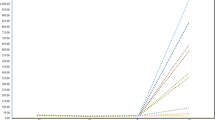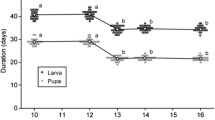Abstract
Selection for fast and slow development in flour beetlesTribolium castaneum (CS) andT. confusum (CF) has resulted in a number of correlated responses in other characters. In general, the fast selected lines of both species have responded similarly with respect to these other traits. The fast lines are characterized by decreased length of time spent in all juvenile stages, decreased size, and essentially the same productivity and hatchability of eggs as the synthetic stocks. In CS-fast there was a substantial decrease in larval survival and an increase in the frequency of abnormal adults. The latter observations did not hold for the CF-fast line.
The CS-slow line, on the other hand, exhibited an increased duration of egg, larval and pupal stages, increased size (at least as determined by pupal weight), and decreased hatchability and larval survival. Productivity also decreased somewhat when measured as the number of eggs per female per day. The frequency of abnormal beetles was also higher in this line than in the foundation stock.
Fitness, as measured by competitive ability, decreased in all selected lines, supporting the notion of an intermediate optimum for developmental rate in the foundation populations.
No evidence was found to support the existence of a compensation mechanism for developmental rate such as that found inDrosophila, whereby faster larval development is compensated for by an increase in the length of the pupal stage.
Similar content being viewed by others
References
Bonnier, G. (1926). Temperature and time of development of the two sexes inDrosophila.Brit. J. Exp. Biol. 4: 186–195.
Campbell, I. M. (1962). Reproductive capacity in the genusChoristoneura Led. (Lepidoptera: Tortricidae). I. Quantitative inheritance and genes as controllers of rates.Can. J. Genet. Cytol. 4: 272–288.
Clayton, G. A., G. R. Knight, J. A. Morris &A. Robertson (1957). An experimental check an quantitative genetical theory. III. Correlated responses.J. Genet. 55: 171–180.
Darwin, C. (1859). On the origin of species by means of natural selection, or the preservation of favored races in the struggle for life. John Murray, London.
Dawson, P. S. (1962). Preliminary report on a possible phenodeviant inT. castaneum.Tribolium Info. Bull. 5: 24–25.
Dawson, P. S. (1965). Genetic homeostatis and developmental rate inTribolium.Genetics.51: 873–885.
Englert, D. C. &A. E. Bell (1960). Genetic differences in the growth curve ofTribolium castaneum Herbst.Genetics. 46: 864.
Falconer, D. S. (1954). Validity of the theory of genetic correlation. An experimental test with mice.J. Hered. 45: 42–44.
Falconer, D. S. (1960). Introduction to quantitative genetics. Oliver and Boyd, London.
Haskell, G. (1954). Correlated responses to polygenic selection in animals and plants.Am. Naturalist. 88: 5–20.
Hiraizumi, Y. (1961). Negative correlation between rate of development and female fertility inDrosophila melanogaster.Genetics. 46: 615–624.
Hollingsworth, M. J. &J. M. Smith (1955). The effects of inbreeding on rate of development and on fertility inDrosophila subobscura.J. Genet. 53: 295–314.
Howe, R. W. (1956). The effect of temperature and humidity on the rate of development and mortality ofTribolium castaneum (Herbst) (Coleoptera, Tenebrionidae).Ann. Appl. Biol. 44: 356–368.
Howe, R. W. (1960). The effects of temperature and humidity on the rate of development and mortality ofTribolium confusum Duval (Coleoptera, Tenebrionidae).Ann. Appl. Biol. 48: 363–376.
Howe, R. W. (1961). Developmental time and weight inTribolium castaneum.Tribolium Info. Bull. 4: 21–22.
Inouye, N. (1963). Metric characters inTribolium.Tribolium Info. Bull. 6: 41–42.
Lerner, I. M. (1954). Genetic homeostasis. Oliver and Boyd, Edinburgh.
Lerner, I. M. (1958). The genetic basis of selection. John Wiley and Sons, New York.
Lerner, I. M. &F. K. Ho (1961). Genotype and competitive ability ofTribolium species.Am. Naturalist. 95: 329–343.
Li, J. C. (1927). The effect of chromosome aberrations on development inDrosophila melanogaster.Genetics.12: 1–58.
Martin, G. A. &A. E. Bell (1960). An experimental check on the accuracy of prediction of response during selection. InKempthorne, O. (Ed.). Biometrical Genetics. Pergamon Press, New York: 178–187.
Mather, K. &B. J. Harrison (1949). The manifold effect of selection.Heredity 3: 1–52, 131–162.
Mayr, E. (1963). Animal species and evolution. Harvard Univ. Press, Cambridge
Park, T., D. B. Mertz &K. Petrusewicz (1961). Genetic strains ofTribolium: their primary characteristics.Physiol. Zool. 34: 62–80.
Reeve, E. C. R. (1954). Natural selection for body size inDrosophila.Caryologia.6 (suppl.): 854–855.
Reeve, E. C. R. &F. W. Robertson (1953). Studies in quantitative inheritance II. Analysis of a strain ofDrosophila melanogaster selected for long wings.J. Genet. 51: 276–316.
Robertson, F. W. (1957). Studies in quantitative inheritance. XI. Genetic and environmental correlations between body size and egg production inDrosophila melanogaster.J. Genet. 55: 428–443.
Siegel, P. B. (1962). A double selection experiment for body weight and breast angle at eight weeks of age in chickens.Genetics. 47: 1313–1319.
Siegel, S. (1956). Nonparametric statistics. McGraw-Hill, New York.
Wigan, L. G. &K. Mather (1942). Correlated response to the selection of polygenic characters.Ann. Eugen. 11: 354–364.
Author information
Authors and Affiliations
Rights and permissions
About this article
Cite this article
Dawson, P.S. Correlated responses to selection for developmental rate inTribolium . Genetica 37, 63–77 (1966). https://doi.org/10.1007/BF01547120
Received:
Issue Date:
DOI: https://doi.org/10.1007/BF01547120




